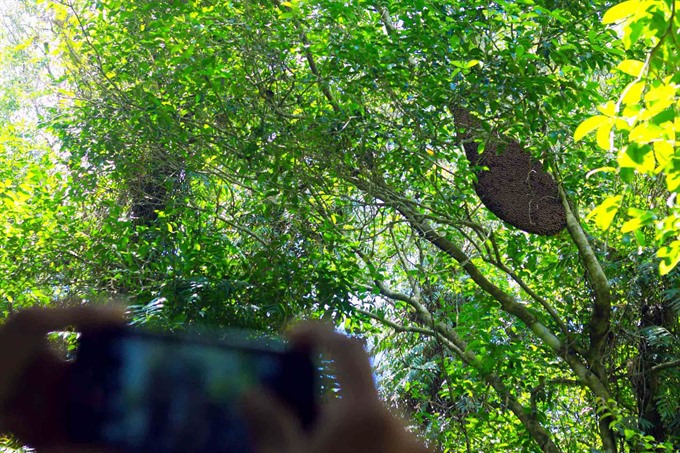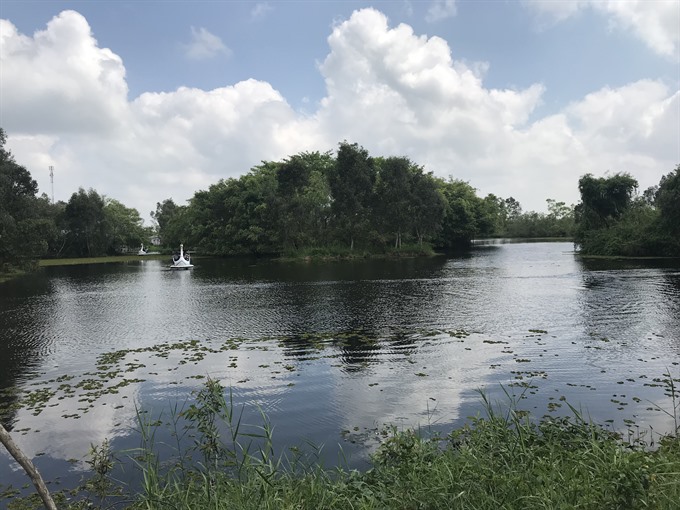Discover Your Inner Child At U Minh National Park

Văn Châu
If you’re a nature lover and favour adventure trips, the U Minh National Park (UMNP) in the Mekong Delta should be at the top of your destination list, especially if you live in southern Việt Nam.
Trần Vĩnh Tuấn, a 46-year-old visitor from HCM City, is so fond of the park that he comes every month or two. “I can fish, breathe the fresh air, and listen to the singing of hundreds of birds,” he said.
“Living and working in HCM City, I have to deal with air and noise pollution. But here, I always feel relaxed and recharged to go back to work the next day.”
The park’s name U Minh, which refers to darkness, remains a mystery to some. It was so called because of the lack of sunlight caused by the density of trees. Even locals at times found it difficult to navigate.
Separated by the rivers Trẹm and Cái Tàu, the park has two major areas called U Minh Thượng (Upper Park) and U Minh Hạ (Lower Park).
The first is located in Kiên Giang Province’s An Minh District, about 65km from Rạch Giá City, and the latter is in Cà Mau Province, 25km from Cà Mau City.
 |
| Greenery: Boats are designed to travel in special flooded forested areas where land travel is impossible. — Photo hcmcgo.com |
Every year, thousands of people visit the park for various outdoor activities, including a climb up to a 24-metre high observatory where there is a panoramic view of the vast forests and waterways.
U Minh Thượng, which covers 21,000 hectares, has a core area of 8,000 ha where many rare and endangered birds live. It contains a total of 187 bird species, 39 amphibian species and 34 fish species.
Widely considered the Mekong Delta’s richest region in terms of plant and animal life, with over 243 species of plants, U Minh Thượng has 32 mammalian species, including the hairy-nosed otter and fishing cat.
U Minh Hạ is also amazingly diverse, with more than 8,000 ha of indigo blue trees and a buffer zone of 25,000 ha that protects all flora and fauna.
 |
| Wildlife: A bee nest in U Minh Hạ. — VNA/VNS Photo Duy Khương |
In 2014, the park management began offering services for tourists, including fishing, and nature discovery and sightseeing trips. Accommodations and boat tours, as well as souvenirs for tourists, are all now available.
Many tourists like to rent boats to travel on the park’s interlacing canals or walk through forested areas, while others prefer fishing or, with the help of locals, spreading nets (with the help of locals) to catch fish that can later cook if they wish.
In recent years, more tall towers have been built where visitors can look for rare animals and plants hidden in the forests.
The park has around 60 kinds of freshwater and brackish-water fish, as well as wild boars, monkeys, weasels, snakes, turtles and pangolins, many of which are listed in the Red Book.
Tourists are also allowed to grill, fry or boil food, or order cooked dishes at the park. The most popular are grilled freshwater fish, grilled snake with water lily, fried field mouse, and young lotus leaves.
Other activities that are bit more adventurous include exploring the flooded indigo forests where people can fish, or trekking to the old barracks of the National Liberation Front armed forces.
 |
| Untouched: The forest is located on a thick layer of peat, which causes the water to look black. — VNS Photo Văn Châu |
Another favourite activity in the indigo tree forest, especially for Vietnamese tourists, is a visit to the house of Uncle Ba Phi, a man famous for his folk stories and comedies loved by generations of local children. Tour guides tell interesting stories about Phi’s fictional giant pythons and crocodiles in the wild.
To protect the environment, the government in recent years has allocated land and forested areas to local residents who make living by planting trees, fishing, trawling, and making wood products, among other activities.
The residents of the area have a deep love for U Minh and take great care in preserving the area, according to authorities.
The park is open year-round, but tourists should be aware that during March and April, when forest fires can break out more easily because of the dry weather, activities in the park are limited in scope and number. — VNS
Revolutionary baseThe U Minh National Park is well known for its rich biodiversity, but few people are aware that is also famous for being a former revolutionary base during military conflicts in Việt Nam. In the last two wars against the French and American, the U Minh mangrove forest was used as a revolutionary base for the South Việt Nam Liberation armed forces. Colonel Phạm Hoàng Kiệt said the area was chosen as a base because U Minh residents were known as hard-working and heroic. The local residents not only supported soldiers, but also protected the leaders of revolutionary movements and their head agencies. The park, which has great significance in the nation’s history, serves as a vivid reminder for today’s youth of the patriotism and revolutionary tradition of older generations. In 2015, the local government built the Security Historical Relics Complex Zone 9 in Kiên Giang Province’s U Minh Thượng District to express respect for and gratitude toward fallen Vietnamese soldiers during the wars with the French and Americans. Now, visitors to the park can discover wildlife and also learn about local history through images and relics of past wars. |
Submarine DeepView24 To Serve Visitors At Vinpearl Nha Trang
US dollar billionaire Phạm Nhật Vượng, Chairman of Vingroup, will put into operation DeepView 24, a spectacularl... Read more
Bánh Khọt A Must-try At Vũng Tàu Beach
Bánh Khọt (mini savory pancake) is a great breakfast dish that visitors must try when staying at Vũng Tàu beach... Read more
Explore The First Museum In Southern Việt Nam
The HCM City Museum of History is located at Nguyễn Bỉnh Kiêm Street in District 1, set beside Saigon Zoo and Bota... Read more
Explore Hidden Waterfall In Central Việt Nam
Tà Puồng Waterfall is one of Việt Nam Central’s most impressive natural sights, with an unspoilt beauty. Read more
Bat Pagoda, Home Of Thousands Of Bats In Mekong Delta
The Cửu Long (Mekong) Delta is home oi about 600 Khmer pagodas and each temple has a unique feature. The Bat Pago... Read more
100-year-old Bửu Sơn Pagoda Rests On One Pillar
The 100-year-old Bửu Sơn Pagoda in Đồng Nai Province, built in the 18th century, rests on only one pillar. Read more

